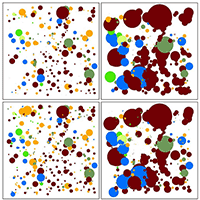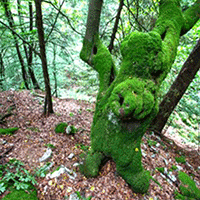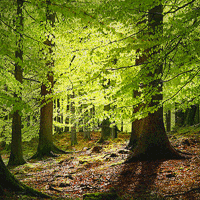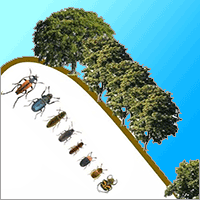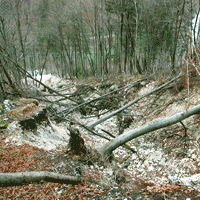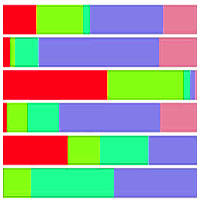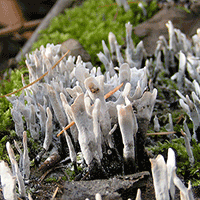Tree-related microhabitats (hereafter TreMs) are structures occurring on trees, such as rot holes, cavities, large nests, mould, fruiting bodies and mycelia of decomposer fungi. TreMs have been widely recognized as important substrates and structures useful for biodiversity conservation in forest ecosystems, and they can be used as indicators for describing and monitoring forest naturalness. However, most studies on the occurrence of TreMs have been mainly done in forest ecosystems of Central Europe, while less research has been conducted in Mediterranean mountain forests. In this study, we investigated the diversity and abundance of 23 types of TreMs on living trees and on deadwood in seven Mediterranean mountains unmanaged forests located in the Apennines (Italy). The abundance of TreMs was evaluated by counting the number of TreMs per tree, while the diversity of TreMs was evaluated by means of the Shannon-Wiener index. We focused on the relationships between diversity and abundance of TreMs, and tree size (e.g., diameter, height, volume), and the time since the last harvest. Among the investigated stands, 2612 living trees, 457 standing dead trees and snags, and 1247 lying deadwood pieces were analysed. For living trees, a generalized linear mixed model was applied to test the effect of several variables on the abundance of TreMs per tree. Diameter at breast height (DBH) of tree stems influenced the abundance and diversity of TreMs. The time since the last harvest also significantly affected the probability that TreMs could be formed in a long-term perspective. The interaction of the predictors “DBH2” and “Years since the last harvest” generated a better model than the one in which the two variables were kept separate. Indeed, these two factors together would better represent the transition of a previously managed forest to a more natural state over time. This study might provide useful information to land managers committed to forestry practices towards sustainable management and biodiversity conservation, especially referring to survey and inventory of forests of high nature value.
Keywords
, , , ,
Citation
Marziliano PA, Antonucci S, Tognetti R, Marchetti M, Chirici G, Corona P, Lombardi F (2021). Factors affecting the quantity and type of tree-related microhabitats in Mediterranean mountain forests of high nature value. iForest 14: 250-259. - doi: 10.3832/ifor3568-014
Academic Editor
Michele Carbognani
Paper history
Received: Jul 01, 2020
Accepted: Mar 25, 2021
First online: May 21, 2021
Publication Date: Jun 30, 2021
Publication Time: 1.90 months
© SISEF - The Italian Society of Silviculture and Forest Ecology 2021
Open Access
This article is distributed under the terms of the Creative Commons Attribution-Non Commercial 4.0 International (https://creativecommons.org/licenses/by-nc/4.0/), which permits unrestricted use, distribution, and reproduction in any medium, provided you give appropriate credit to the original author(s) and the source, provide a link to the Creative Commons license, and indicate if changes were made.

Breakdown by View Type
(Waiting for server response...)
Article Usage
Total Article Views: 36763
(from publication date up to now)
Breakdown by View Type
HTML Page Views: 30230
Abstract Page Views: 3305
PDF Downloads: 2610
Citation/Reference Downloads: 8
XML Downloads: 610
Web Metrics
Days since publication: 1667
Overall contacts: 36763
Avg. contacts per week: 154.37
Article Citations
Article citations are based on data periodically collected from the Clarivate Web of Science web site
(last update: Mar 2025)
Total number of cites (since 2021): 10
Average cites per year: 2.00
Publication Metrics
by Dimensions ©
Articles citing this article
List of the papers citing this article based on CrossRef Cited-by.
(1)
Bani A, Pioli S, Ventura M, Panzacchi P, Borruso L, Tognetti R, Tonon G, Brusetti L (2018)The role of microbial community in the decomposition of leaf litter and deadwood. Applied Soil Ecology 126: 75-84.
CrossRef |
Gscholar
(2)
Bouget C, Larrieu L, Brin A (2014)Key features for saproxylic beetle diversity derived from rapid habitat assessment in temperate forests. Ecological Indicators 36: 656-664.
CrossRef |
Gscholar
(3)
Bütler R, Lachat T, Larrieu L, Paillet Y (2013)Habitat trees: key elements for forest biodiversity. In: “Integrative Approaches as an Opportunity for the Conservation of Forest Biodiversity”. European Forest Institute, Joensuu, Finland, pp. 284.
Online |
Gscholar
(4)
Dixon PM (1993)The bootstrap and the jackknife: describing the precision of ecological indices. In: “Design and Analysis of Ecological Experiments” (Scheiner SM, Gurevitch J eds). Chapman and Hall, New York, USA, pp. 290-318.
Online |
Gscholar
(5)
Emborg J, Christensen M, Heilmann-Clausen J (2000)The structural dynamics of Suserup Skov, a near-natural temperate deciduous forest in Denmark. Forest Ecology and Management 126: 173-189.
CrossRef |
Gscholar
(6)
Großmann J, Schultze J, Bauhus J, Pyttel P (2018)Predictors of microhabitat frequency and diversity in mixed mountain forests in South-Western Germany. Forests 9: 104.
CrossRef |
Gscholar
(7)
Grove SJ (2002)Saproxylic insect ecology and the sustainable management of forests. Annual Review of Ecology and Systematics 33: 1-23.
CrossRef |
Gscholar
(8)
Hilmers T, Friess N, Bässler C, Heurich M, Brandl R, Pretzsch H, Seidl Müller R J (2018)Biodiversity along temperate forest succession. Journal of Applied Ecology 55: 2756-2766.
CrossRef |
Gscholar
(9)
Hunter ML (1990)Wildlife, forests, and forestry. Principles of managing forests for biological diversity. Prentice Hall, Englewood Cliffs, New Jersey, USA, pp. 370.
Online |
Gscholar
(10)
Johann F, Schaich H (2016)Land ownership affects diversity and abundance of tree microhabitats in deciduous temperate forests. Forest Ecology and Management 380: 70-81.
CrossRef |
Gscholar
(11)
Kozák D, Mikoláš M, Svitok M, Bače R, Paillet Y, Larrieu L, Nagel TA, Begovič K, Cada V, Diku A, Frankovič M, Janda P, Kameniar O, Keren S, Kjučukov P, Lábusová J, Langbehn T, Málek J, Mikac S, Morrissey RC, Nováková MH, Schurrman JS, Svobodová K, Synek M, Teodosiu M, Toromani E, Trotsiuk V, Vítková L, Svoboda M (2018)Profile of tree-related microhabitats in European primary beech-dominated forests. Forest Ecology and Management 429 (10): 363-374.
CrossRef |
Gscholar
(12)
Lambert D (1992)Zero-inflated Poisson regression, with an application to defects in manufacturing. Technometrics 34: 1-14.
CrossRef |
Gscholar
(13)
Larrieu L, Cabanettes A (2012)Species, live status, and diameter are important tree features for diversity and abundance of tree microhabitats in subnatural montane beech-fir forests. Canadian Journal of Forest Research 42: 1433-1445.
CrossRef |
Gscholar
(14)
Larrieu L, Cabanettes A, Delarue A (2012)Impact of silviculture on dead wood and on the distribution and frequency of tree microhabitats in montane beech-fir forests of the Pyrenees. European Journal of Forest Research 131: 773-786.
CrossRef |
Gscholar
(15)
Larrieu L, Cabanettes A, Gonin P, Lachat T, Paillet Y, Winter S, Bouget C, Deconchat M (2014)Deadwood and tree microhabitat dynamics in unharvested temperate mountain mixed forests: a life-cycle approach to biodiversity monitoring. Forest Ecology and Management 334: 163-173.
CrossRef |
Gscholar
(16)
Larrieu L, Cabanettes A, Gouix N, Burnel L, Bouget C, Deconchat M (2017)Development over time of the tree-related microhabitat profile: the case of lowland beech-oak coppice-with-standards set-aside stands in France. European Journal of Forest Research 136: 37-49.
CrossRef |
Gscholar
(17)
Larrieu L, Paillet Y, Winter S, Bütler R, Kraus D, Krumm F, Thibault L, Michel AK, Regnery B, Vandekerkhove K (2018)Tree related microhabitats in temperate and Mediterranean European forests: a hierarchical typology for inventory standardization. Ecological Indicators 84: 194-207.
CrossRef |
Gscholar
(18)
Lindenmayer DB (2017)Conserving large old trees as small natural features. Biological Conservation 211: 51-59.
CrossRef |
Gscholar
(19)
Lindenmayer DB, Banks SC, Laurance WF, Franklin JF, Likens GE (2014)Broad decline of populations of large old trees. Conservation Letters 7: 72-73.
CrossRef |
Gscholar
(20)
Lombardi F, Lasserre B, Chirici G, Tognetti R, Marchetti M (2012)Deadwood occurrence and forest structure as indicators of old-growth forest conditions in Mediterranean mountainous ecosystems. Écoscience 19 (4): 344-355.
CrossRef |
Gscholar
(21)
Lombardi F, Marchetti M, Corona P, Merlini P, Chirici G, Tognetti R, Burrascano S, Alivernini A, Puletti N (2015)Quantifying the effect of sampling plot size on the estimation of structural indicators in old-growth forest stands. Forest Ecology and Management 346: 89-97.
CrossRef |
Gscholar
(22)
Marchetti M, Tognetti R, Lombardi F, Chiavetta U, Palumbo G, Sellitto M, Colombo C, Iovieno P, Alfani A, Baldantoni D, Barbati A, Ferrari B, Bonacquisti S, Capotorti G, Copiz R, Blasi C (2010)Ecological portrayal of old-growth forests and persistent woodlands in the Cilento and Vallo di Diano National Park (southern Italy). Plant Biosystems 144: 130-147.
CrossRef |
Gscholar
(23)
Marti JA (2001)A new method for non-parametric multivariate analysis of variance. Austral Ecology 26: 32-46.
CrossRef |
Gscholar
(24)
McArdle BH, Anderson MJ (2001)Fitting multivariate model to semi-metric distances: a comment on distance-based redundancy analysis. Ecology 82: 290-297.
CrossRef |
Gscholar
(25)
Michel AK, Winter S (2009)Tree microhabitat structures as indicators of biodiversity in Douglas-fir forests of different stand ages and management histories in the Pacific Northwest, USA. Forest Ecology and Management 257: 1453-1464.
CrossRef |
Gscholar
(26)
Nagel TA, Svoboda M, Diaci J (2006)Regeneration patterns after intermediate wind disturbance in an old-growth
Fagus-Abies forest in southeastern Slovenia. Forest Ecology and Management 226: 268-278.
CrossRef |
Gscholar
(27)
Paillet Y, Archaux F, Puy S, Bouget C, Boulanger V, Debaive N, Gilg O, Gosselin F, Guilbert E (2018)The indicator side of tree microhabitats: a multi-taxon approach based on bats, birds and saproxylic beetles. Journal of Applied Ecology 55: 2147-2159.
CrossRef |
Gscholar
(28)
Paillet Y, Archaux F, Boulanger V, Debaive N, Fuhr M, Gilg O, Gosselin F, Guilbert E (2017)Snags and large trees drive higher tree microhabitat densities in strict forest reserves. Forest Ecology and Management 389: 176-186.
CrossRef |
Gscholar
(29)
Paillet Y, Debaive N, Archaux F, Cateau E, Gilg O, Guilbert E (2019)Nothing else matters? Tree diameter and living status have more effects than biogeoclimatic context on microhabitat number and occurrence: an analysis in French forest reserves. PLoS One 14 (5): e0216500.
CrossRef |
Gscholar
(30)
Parisi F, Lombardi F, Sciarretta A, Tognetti R, Campanaro A, Marchetti M, Trematerra P (2016)Spatial patterns of saproxylic beetles in a relic silver fir forest (Central Italy), relationships with forest structure and biodiversity indicators. Forest Ecology and Management 381: 217-234.
CrossRef |
Gscholar
(31)
Parisi F, Pioli S, Lombardi F, Fravolini G, Marchetti M, Tognetti R (2018)Linking deadwood traits with saproxylic invertebrates and fungi in European forests - a review. iForest 11: 423-436.
CrossRef |
Gscholar
(32)
Parisi F, Di Febbraro M, Lombardi F, Biscaccianti AB, Campanaro A, Tognetti R, Marchetti M (2019)Relationships between stand structural attributes and saproxylic beetle abundance in a Mediterranean broadleaved mixed forest. Forest Ecology and Management 432: 957-966.
CrossRef |
Gscholar
(33)
Parisi F, Lombardi F, Marziliano PA, Russo D, De Cristofaro A, Marchetti M, Tognetti R (2020)Diversity of saproxylic beetle communities in chestnut agroforestry systems. iForest 13: 456-465.
CrossRef |
Gscholar
(34)
Peterken GF (1996)Natural woodland: ecology and conservation in northern temperate regions. Cambridge University Press, Cambridge, UK, pp. 540.
Online |
Gscholar
(35)
Puettmann K, Coates D, Messier C (2009)A critique of silviculture: managing for complexity. Island Press, Washington, DC, USA, pp. 188.
Online |
Gscholar
(36)
R Core Team (2019)R: a language and environment for statistical computing. R Foundation for Statistical Computing, Vienna, Austria.
Online |
Gscholar
(37)
Regnery B, Paillet Y, Couvet D, Kerbiriou C (2013)Which factors influence the occurrence and density of tree microhabitats in Mediterranean oak forests? Forest Ecology and Management 295: 118-125.
CrossRef |
Gscholar
(38)
Rosenvald R, Lõhmus A (2008)For what, when, and where is green-tree retention better than clear-cutting? A review of the biodiversity aspects. Forest Ecology and Management 255 (1): 1-15.
CrossRef |
Gscholar
(39)
Seymour RS, White AS, De Maynadier PG (2002)Natural disturbance regimes in northeastern North America - evaluating silvicultural systems using natural scales and frequencies. Forest Ecology and Management 155: 357-367.
CrossRef |
Gscholar
(40)
Shannon CE (1948)A mathematical theory of communication. Bell System Technical Journal 27 (4): 623-656.
CrossRef |
Gscholar
(41)
Stokland JN, Siitonen J, Jonsson BG (2012)Biodiversity in dead wood. Cambridge University Press, New York, NY, USA, pp. 524.
Gscholar
(42)
Tabacchi G, Di Cosmo L, Gasparini P (2011)Aboveground tree volume and phytomass prediction equations for forest species in Italy. European Journal of Forest Research 130: 911-934.
CrossRef |
Gscholar
(43)
Vuidot A, Paillet Y, Archaux F, Gosselin F (2011)Influence of tree characteristics and forest management on tree microhabitats. Biological Conservation 144: 441-450.
CrossRef |
Gscholar
(44)
Winter S, Flade M, Schumacher H, Kerstan E, Möller G (2005)The Importance of near-natural stand structures for the biocoenosis of lowland beech forests. Forest, Snow and Landscape Research 79 (1): 127-144.
Gscholar
(45)
Winter S, Möller GC (2008)Microhabitats in lowland beech forests as monitoring tool for nature conservation. Forest Ecology and Management 255: 1251-1261.
CrossRef |
Gscholar
(46)
Zuur AF, Ieno EN, Elphick CS (2010)A protocol for data exploration to avoid common statistical problems. Methods in Ecology and Evolution 1 (1): 3-14.
CrossRef |
Gscholar
(47)
Zuur AF, Hilbe JM, Ieno EN (2013)A beginner’s guide to GLM and GLMM with R: a frequentist and Bayesian perspective for ecologists. Highland Statistics Ltd., Newburgh, UK, pp. 256.
Gscholar


